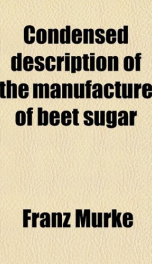condensed description of the manufacture of beet sugar

Purchase of this book includes free trial access to www.million-books.com where you can read more than a million books for free. This is an OCR edition with typos. Excerpt from book: CHAPTER IV THE DIFFUSION PROCESS From the beet cutters the cossettes generally fall on a cossette conveyor, usually a rubber or gutta percha belt in the case of a long battery, or a movable metal trough or spout in the case of a circular battery. They are then transported to the different diffusion cells. The two principal types of diffusion batteries are the circular and the straight battery; the former has the advantage of having the different valves closer together; but it cannot be enlarged as easily as a straight battery. The contents of the diffusion cells vary from 30 to 80 HL and their number varies from eight to fourteen in a battery. The size of the cells, of course, varies with the capacity of the house. To give some idea of the proportion of a battery as to capacity, it is only necessary to state that a battery of fourteen cells of 70 HL capacity each, with chains inside of the battery cells, is considered necessary for a daily capacity of 1100 long tons. Such a battery, working over twelve cells, has an amount of 44 to 46 tons of cosettes in circulation and has to draw eleven to twelve cells per hour, which means that about 45 tons of beets have to pass through the battery per hour. There are two different types of cells which are most commonly used. One type consists of cylindrical cells with upper filling door and low side-discharge door, with a flat double bottom with a slight inclination toward the door, the upper bottom being a perforated sieve on which the cossettes rest. The juice which enters the cell at the top neck passes downward through the cossettes in the cell and out through the sieves. From under the sieves it goes through a pipe to the top of the next cell. Opposite the discharge door there is a water pipe for cleaning the cell after t...
Info about the book
Author:
Series:
Unknown
ASIN:
B0032KV4PA
Rating:
2.5/5 (4)Your rating:
0/5
Languge:
English
Users who have this book
Users who want this book
What readers are saying
What do you think? Write your own comment on this book!
write a commentGenre
if you like condensed description of the manufacture of beet sugar try:
Other books by this author
Do you want to read a book that interests you? It’s EASY!
Create an account and send a request for reading to other users on the Webpage of the book!

